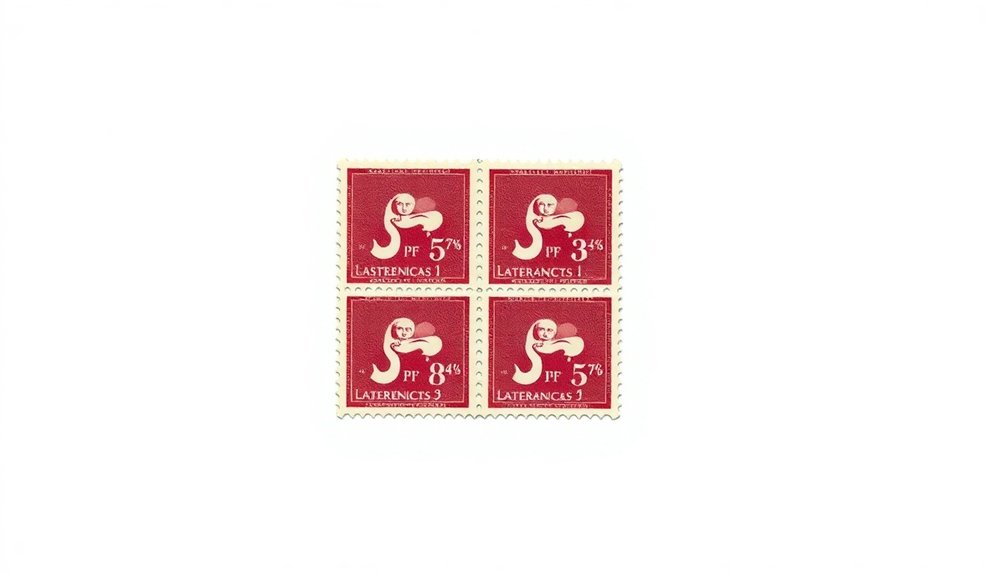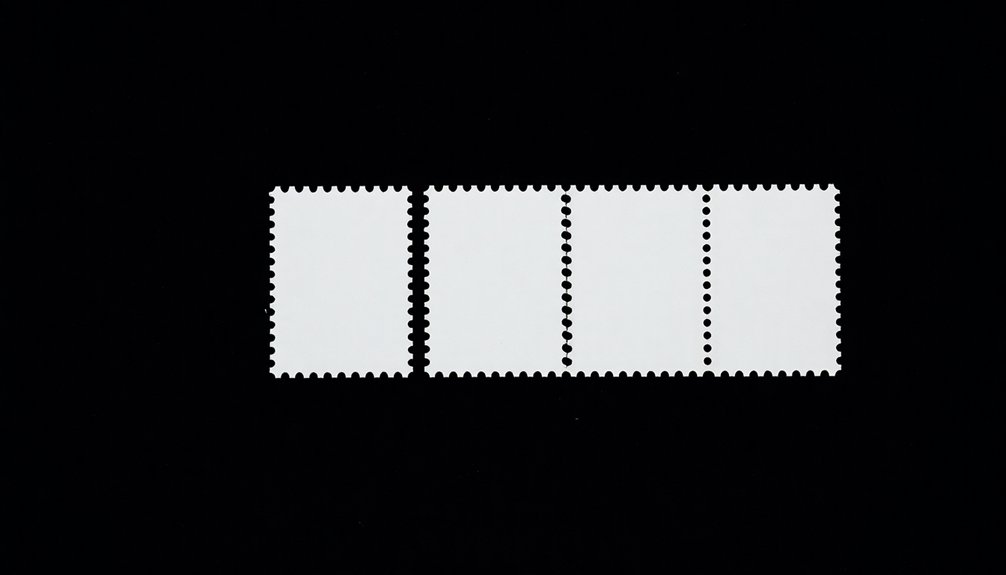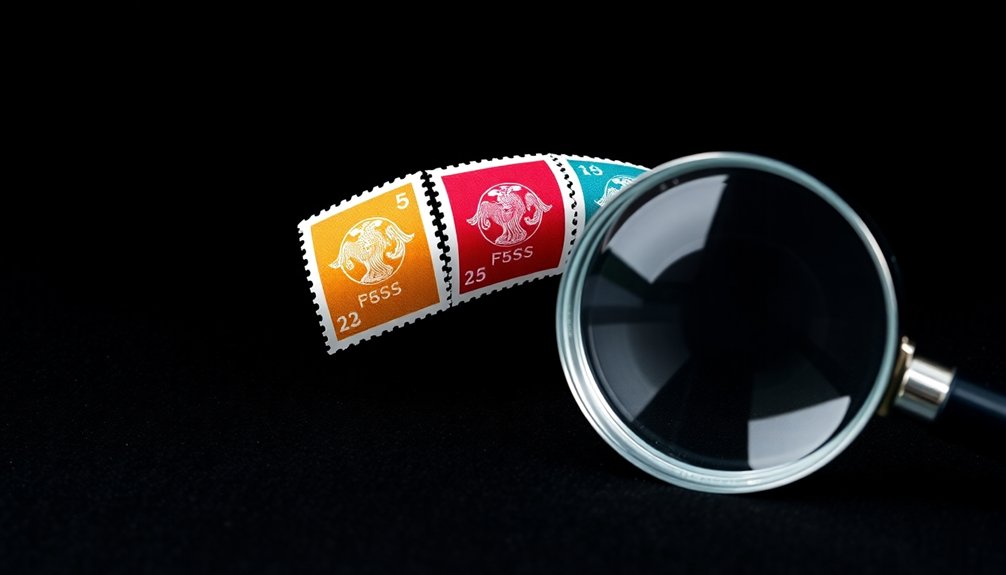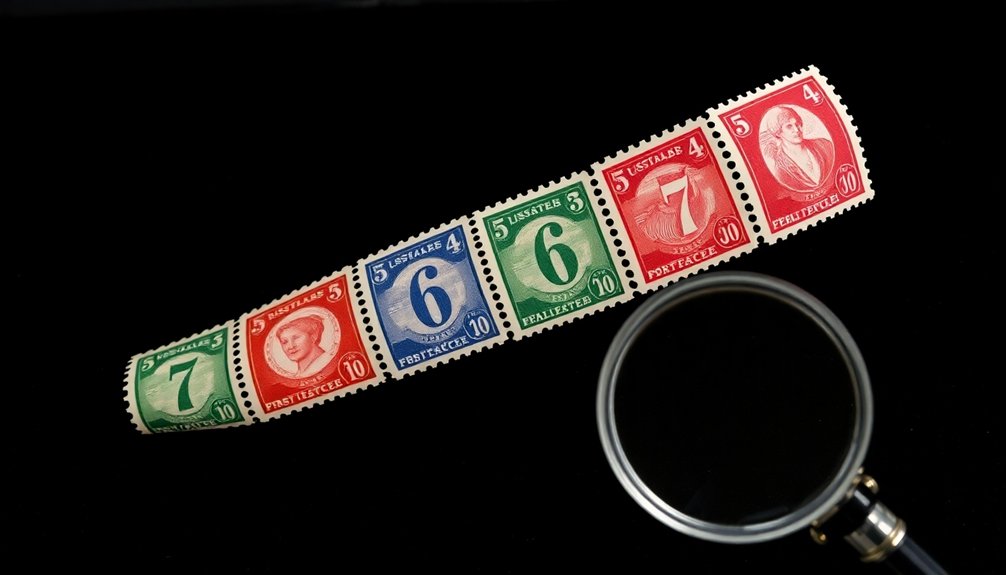If you're seeking a distinctive collecting niche, Plate Number Coils (PNCs) offer a fascinating philatelic pursuit. These specialized stamps feature unique printed numbers every 24 or 52 stamps in a coil roll, identifying specific printing plates used in production. You'll find collectors often focus on obtaining strips of five stamps with the numbered stamp centered. The market for PNCs has seen remarkable peaks, with some specimens valued at 50 times their face value. There's much more to discover about these numerical treasures.
Key Takeaways
- Plate Number Coils feature unique identifying numbers that make each strip special, appearing every 24 or 52 stamps in a roll.
- Collectors particularly value strips of five stamps with the numbered stamp centered, creating a desirable presentation format.
- Some rare PNCs, like the 1995 Space Shuttle plate number 1, can be worth thousands due to their limited availability.
- PNCs represent an important aspect of printing history, showcasing the evolution of stamp production methods since the 1970s.
- Digital tracking and authentication methods have made PNC collecting more accessible and reliable for modern philatelists.
What Are Plate Number Coils?

In stamp collecting, plate number coils (PNCs) are specialized stamps that show a small printed number on the front, typically appearing every 24 or 52 stamps in a coil roll.
You'll find these numbers identify the specific printing plate used to produce the stamps. When you're examining a PNC, you'll notice the plate number appears as a single digit or multiple digits printed in the bottom margin of the stamp. These numbers are essential for tracking printing variations and helping collectors identify specific printing plates.
PNCs became popular in the late 1970s when the Bureau of Engraving and Printing began using more sophisticated printing methods.
If you're collecting PNCs, you'll want to focus on obtaining strips of five stamps, with the numbered stamp positioned in the center.
The History and Evolution of PNC Collecting
You'll find PNC collecting emerged in the early 1970s when specialists started noticing and preserving plate numbers on coil stamps.
Your collection's value might've peaked during the 1980s market boom, when some PNCs commanded prices 50 times higher than their face value.
Today, you can use digital databases and online tools to track PNC varieties, market values, and trading patterns more effectively than ever before.
Early PNC Collecting Origins
While stamp collecting dates back to the 1840s, collectors didn't begin focusing on plate number coils (PNCs) until the early 1900s.
You'll find that the first documented PNC collections emerged when the Bureau of Engraving and Printing started adding plate numbers to coil stamps in 1981.
Before that time, you wouldn't have seen much interest in these specialized items. The turning point came when collectors noticed tiny numbers appearing on their coil stamps. Soon, they began saving strips of three to five stamps that showcased these distinctive plate numbers.
Notable Value Trends 1980-Present
Since their introduction in 1981, PNC values have shown remarkable fluctuations driven by collector demand and market conditions.
You'll find that early PNCs from the 1980s peaked in value during the mid-1990s collecting boom, with some strips reaching hundreds of dollars. However, prices have generally stabilized since 2000.
Today, you can expect to pay $2-5 for most modern PNC strips, while scarcer varieties from the 1980s still command $20-50.
The highest values remain with production errors and rare plate numbers, particularly those from the Transportation series.
If you're building an investment-grade collection, focus on early numbers under 10000 and documented errors.
While the market isn't as hot as it was in the 1990s, PNCs continue to hold steady appeal among specialized collectors.
Modern Digital Tracking Methods
The digital age has transformed how collectors track and manage their PNC holdings. You'll find numerous specialized software programs and mobile apps designed specifically for PNC collecting, allowing you to catalog your collection with precision.
These digital tools let you scan, photograph, and document each coil's details, including plate numbers, postal rates, and condition grades. You can now use cloud-based databases to sync your inventory across devices and back up your records securely.
Online platforms help you track market values in real-time, while specialized forums connect you with other collectors to share information and trade pieces. Digital authentication services also make it easier to verify genuine PNCs and detect counterfeits.
How to Identify Authentic Plate Number Coils

Determining authentic plate number coils requires careful attention to several key characteristics that distinguish genuine examples from counterfeits.
You'll need to examine the paper quality, ink consistency, and perforation gauge using a specialized perforation gauge tool. Check that the plate number's print quality matches known genuine examples and verify that it's consistent with the period's printing technology.
Look for the distinct printing characteristics of the era, such as specific color variations and paper fluorescence under UV light.
You'll also want to confirm that the number sequence matches official records for that particular issue. If you're unsure, compare your coil to verified examples in reference catalogs or seek authentication from a recognized philatelic expert.
Remember to check for proper gum consistency and distribution on unused specimens.
Essential Tools for PNC Collection and Storage
After mastering authentication techniques, you'll need proper equipment to maintain your plate number coil collection.
Essential tools include stamp tongs to safely handle stamps, a high-quality magnifying glass for examining details, and specialized PNC albums designed to protect strips. You'll also want stock books with clear protective sleeves and acid-free pages.
For precise measurements and positioning, you should invest in a perforation gauge and ruler.
Keep your collection safe from environmental damage with humidity controls and UV-protective storage containers.
Don't forget to have proper lighting at your workspace – a desk lamp with adjustable brightness helps you spot plate numbers and varieties.
Finally, organize your collection with an extensive inventory system, whether it's specialized software or a detailed spreadsheet of your PNC holdings.
Building Your PNC Collection: Where to Start

Starting a plate number coil collection begins with three key decisions: your collecting focus, budget, and acquisition strategy.
You'll need to decide whether to collect modern issues, vintage coils, or specific denomination ranges. Consider if you want single numbers, strips of three or five, or complete sets.
Set a realistic budget that matches your collecting goals. Modern PNCs are generally affordable, while pre-1981 issues can be quite expensive.
You can build your collection through stamp dealers, online auctions, or trading with fellow collectors.
Start with readily available items and gradually expand. Join a PNC specialty group to learn from experienced collectors and access their trading networks.
Subscribe to dealer newsletters to stay informed about new offerings and market prices. Don't forget to check stamp shows and bourses for hidden gems.
Notable Rarities and Valuable Varieties
Several highly sought-after PNC rarities command exceptional prices in today's market.
You'll find the 1995 $10.75 Space Shuttle plate number 1 among the most valuable, with fewer than 100 known examples. The 1981 18¢ "For U.S. Mail Use Only" variety with plate number 1 remains another prize catch, selling for thousands when found in pristine condition.
Don't overlook printing errors, which can dramatically increase value. The 1995 32¢ Flag over Porch with a missing red stripe and the 1981 "C" stamp with an inverted plate number stand out as notable varieties.
You'll also want to watch for scarce number combinations, like the 1995 32¢ Flag coil with plate number 66666, which collectors actively pursue.
Early experimental coils from the 1908-1910 period represent the pinnacle of PNC collecting.
Tips for Trading and Selling PNCs

Trading and selling plate number coils requires careful attention to market conditions and proper documentation.
You'll need to grade your PNCs accurately, noting any damage, centering issues, or perforation irregularities. Keep detailed records of your purchases, including dates and sources.
When you're ready to sell, research current market values through dealer catalogs and online auction sites. You can list your PNCs on specialized stamp trading websites, eBay, or connect with local stamp clubs.
Make sure you photograph your items clearly, showing both the stamp and plate number. Consider getting certificates of authenticity for high-value pieces.
Don't forget to package your PNCs properly for shipping using stamp mounts or glassine envelopes. Track your shipments and insure valuable items to protect your investment.
Conclusion
You'll find that plate number coils offer a fascinating niche in stamp collecting that's both rewarding and challenging. Whether you're just starting out or expanding your existing collection, PNCs provide unique opportunities to discover rare varieties and build valuable sets. Remember to invest in proper storage materials and stay connected with other collectors – you'll be amazed at how quickly your PNC collection can grow.
